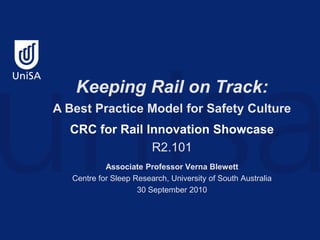2010 CRC Showcase - Safety & Security - Safety Culture Management R2.101
- 1. Keeping Rail on Track: A Best Practice Model for Safety Culture CRC for Rail Innovation Showcase R2.101 Associate Professor Verna Blewett Centre for Sleep Research, University of South Australia 30 September 2010
- 2. Research Team UniSA • Project Leader: Assoc Prof Verna Blewett • Dr Sophia Rainbird (now) • Dr Jill Dorrian (statistical analyses) • Dr Kasia Jaworski (from Nov 2010) Steering Committee • Alex Borodin (ARA) - Chair • Reps from the three companies • Verna Blewett
- 3. Safety Culture Some contradictions: – A contested concept – We „know what it means‟ – Accepted as fundamental to high performance in safety – Need to assess safety culture performance – View safety culture as part of organisational culture
- 4. This Research • Funded by the CRC for Rail Innovation – R2.101 • Three rail organisations as partners: – RailCorp NSW, PTA WA, GWA SA – In-kind and cash contribution • Use/test RSSB Safety Culture Toolkit – Hard copy questionnaire, analysis at UniSA • Use Digging Deeper as analytical framework • Quantitative and qualitative data collection
- 5. Research Aims • Build a Model of Best Practice for Safety Culture in the Australian Rail Industry • Test the RSSB Safety Culture Survey • Test the 10 Platinum Rules from Digging Deeper project as a framework for action • Identify improvements in the RSSB Safety Culture Survey • Participatively identify interventions at enterprise level in response to identified gaps in Safety Culture
- 6. Research Outcomes For industry • A Model of Best Practice for Safety Culture in the Australian Rail Industry • An upgraded Safety Culture Toolkit that is validated for use in the Australian Rail Industry For participating firms • An evidence-base for future action • At enterprise level - participatively developed interventions in response to identified gaps in Safety Culture as the first step to improvement
- 7. Research Method • Establish Reference Group in each company • Choose areas of organisation for study • Ethics approval from UniSA HREC • Run baseline RSSB Safety Culture Survey • Analyse data – to inform next stage • Conduct interviews and focus groups on site • Analyse data – to inform next stage • Participatively develop interventions – Future Inquiry • Review outcomes of the interventions if time permits • Follow up RSSB Safety Culture Survey • Write report/papers
- 8. Confidentiality & credibility Confidentiality is key to good data: – Questionnaire is anonymous – Size of population groups for analysis is 15 or larger – Individuals (focus groups/interviews) not identified in reports/papers – Only de-identified and aggregated data provided to companies and in reports, papers etc – Triangulation of data sources – Ethics approval from UniSA HREC – Robust method, data and data analysis
- 9. Future Inquiry • An efficient one-day planning meeting • “Whole system” in the room • Look for common ground • Future focus • Examines past, present, future • Builds on what works • Groundwork for action plans • Engages new alliances for action • Creates commitment to action
- 11. Digging Deeper • Commissioned by the NSW Mines Safety Advisory Committee & NSW Dept of Primary Industries. – Production bonus and safety incentive schemes – OHS management systems and consultation – Hours of work and fatigue management – 53 sites, quantitative data and qualitative data – Aimed at industry improvement – Used FIW to develop industry strategies
- 12. 10 Platinum Rules • Codify the fundamental steps to effectively manage OHS • Make it clear how the gaps in performance and action can be filled • Apply at all levels in the organisation/industry • Are a starting point for change • In this project are an analytical framework
- 13. 10 Platinum Rules Rule 1 Rule 2 Remember you are Listen to and talk with working with your people people  Be inclusive  Don‟t exhaust them  Do it often  People aren‟t  Value and develop machines people skills in  Treat them with supervisors and dignity and respect managers
- 14. 10 Platinum Rules Rule 3 Rule 4 Fix things promptly Make sure your paperwork is worth  Don‟t let issues fester having  Keep people informed  Keep it current of progress  Make sure it‟s  Don‟t let them think meaningful things only happen in the land where pigs fly
- 15. 10 Platinum Rules Rule 5 Rule 6 Improve competence Encourage people in OHS to give you bad news  particularly at management levels  Canaries are the most important workers in a mine
- 16. 10 Platinum Rules Rule 7 Rule 8 Fix your workplace Measure and monitor first risks that people are exposed to  Before even thinking about the bells and  Don‟t just react to whistles! incidents: fix things before they happen. Control risks at their source.
- 17. 10 Platinum Rules Rule 9 Rule 10 Keep checking that Apply adequate what you are doing resources in time is working effectively and money  Are you achieving what you think you are?  Do you know where you are in OHS?
- 18. The only way to make a workplace healthy and safe is to make it healthy and safe there is no substitute for action!
- 19. Digging Deeper full report available free from: http://www.dpi.nsw.gov.au/minerals/ safety/consultation/digging-deeper or just google digging deeper



















